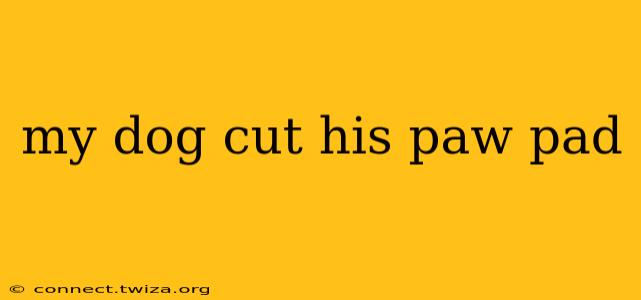It's heartbreaking to see your furry friend injured, and a cut paw pad is a common yet distressing problem for dog owners. This comprehensive guide will walk you through identifying the severity of the injury, providing first aid, and preventing future paw pad injuries. We'll also address some frequently asked questions to help you navigate this situation effectively.
How to Tell if Your Dog's Paw Pad Cut is Serious?
The severity of your dog's paw pad cut depends on several factors: the depth of the cut, its location, and whether it's bleeding heavily. Minor cuts often involve superficial scratches or scrapes. These typically heal on their own with proper cleaning and care. However, deep cuts, those that bleed profusely, or cuts near the sensitive areas of the paw require immediate veterinary attention. Look for signs of infection like swelling, redness, pus, or limping that worsens over time.
What Should I Do if My Dog Cuts His Paw Pad?
Immediate action is crucial. First, remain calm to help soothe your dog. Then, follow these steps:
- Examine the Injury: Carefully assess the wound. Note its depth, location, and the amount of bleeding.
- Clean the Wound: Use a clean cloth and lukewarm water to gently remove any dirt, debris, or foreign objects. Avoid using harsh chemicals or hydrogen peroxide, as these can damage the tissue.
- Control Bleeding: If bleeding is significant, apply gentle but firm pressure with a clean cloth for about 10-15 minutes. Consider using a styptic powder (available at most pet stores) to help stop bleeding quickly, but always follow the manufacturer's instructions.
- Bandage (If Necessary): For minor cuts, a bandage may not be necessary. However, for deeper cuts or if bleeding persists, you may need to gently bandage the paw, ensuring the bandage is not too tight to restrict blood flow.
- Monitor for Infection: Watch for signs of infection such as swelling, increased pain, redness, pus, or a foul odor. If you notice any of these signs, contact your veterinarian immediately.
- Veterinary Consultation: For deep wounds, heavy bleeding, signs of infection, or if you're unsure how to manage the injury, a veterinary visit is essential. They can properly assess the damage, clean the wound, stitch it if needed, and provide appropriate pain relief and antibiotics if necessary.
How Long Does it Take for a Dog's Paw Pad to Heal?
Healing time depends heavily on the wound's severity. Minor cuts usually heal within a few days to a week with proper care. Deep cuts or those requiring stitches may take several weeks to heal completely. Your veterinarian will be able to provide a more accurate estimate based on the specific injury.
How Can I Prevent My Dog from Cutting His Paw Pads?
Prevention is key to avoiding paw pad injuries. Here are some helpful tips:
- Regular Paw Pad Inspections: Regularly inspect your dog's paws for cuts, cracks, or foreign objects embedded in the pads.
- Protective Footwear: Consider using dog boots, especially in harsh weather conditions (hot pavement, ice, snow, or rough terrain).
- Trim Nails Regularly: Long nails can make dogs more prone to paw pad injuries.
- Avoid Hot Surfaces: Always check the temperature of pavement before walking your dog, especially during hot summer days.
- Careful Walks in Rough Terrain: Be mindful of sharp objects or rough surfaces while walking your dog.
What if My Dog Licks His Paw Pad Wound?
Licking can hinder the healing process and introduce bacteria, potentially leading to infection. Consider using a protective cone or Elizabethan collar to prevent your dog from licking the wound. Your vet may also recommend a bitter-tasting spray to deter licking.
Can I Put Neosporin on My Dog's Paw Pad Cut?
It's best to consult your veterinarian before applying any human medication to your dog's wound. Many human products contain ingredients that can be toxic to dogs. Your vet can recommend appropriate topical treatments.
Remember, this information is for general guidance only. Always consult with your veterinarian for any concerns about your dog's health and well-being. Early intervention and proper care are crucial for ensuring a swift and complete recovery.
